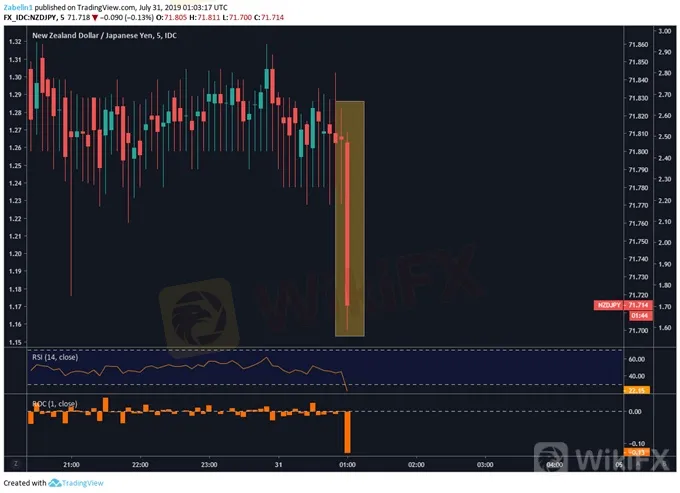简体中文
繁體中文
English
Pусский
日本語
ภาษาไทย
Tiếng Việt
Bahasa Indonesia
Español
हिन्दी
Filippiiniläinen
Français
Deutsch
Português
Türkçe
한국어
العربية
NZDJPY Plunges After New Zealand Confidence Data Spooks Markets
Abstract:The New Zealand Dollar fell against most of its major counterparts after local confidence data undershot forecasts and spooked markets – NZD is now eyeing FOMC rate decision ahead.
NEW ZEALAND DATA, NZD, TRADE WARS, FOMC – TALKING POINTS
-
NZDJPY plunged after local confidence data shriveled, spooked markets
Earlier this month, RBNZ said it is looking into “unconventional” policies
US-China trade war continues to remain a headline risk for the economy
Learn how to identify and trade political risk here!
The New Zealand Dollar fell against most of its major counterparts after ANZ business confidence data came in at -44.3, worse than the previous reading at -38.1 and is now resting at its lowest point since September 2018. Deteriorating global growth and a major slowdown in China – New Zealands main trading partner – has negatively impacted the export-dependent economy.
New Zealand Dollar Falls Against Japanese Yen After Data Disappointed
NZD chart created using Tradingview
The Reserve Bank of New Zealand (RBNZ) has already cut the benchmark overnight cash rate once this year from 1.75 percent to 1.50 percent and has hinted at introducing additional “unconventional” monetary policy measures to boost inflation. One of the biggest factors that will likely continue to impact officials at the RBNZ is the US-China trade war which may get worse before it gets better.
THERE WILL BE A ‘GREAT DEAL’ OR NONE AT ALL: US-CHINA TRADE WAR UPDATE
United States Trade Representative Robert Lighthizer and a US delegation are currently in Shanghai attending a two-day meeting with their Chinese counterparts to discuss US-China trade relations. The talks are not expected to bear any meaningful fruit but will likely end with both sides offering small gestures of good faith as a way to show Beijing and Washington are making progress.
However, commentary and policy measures from the White House say otherwise – quite literally. US President Donald Trump expressed his dissatisfaction with China, complaining that “they just dont come through”. Two weeks before that, Trump ordered the Defense Department to increase production of rare earth magnets out of concern China may use its mineral ban as leverage in the negotiations.
What other leverage can China use in trade negotiations?
Looking ahead, traders will continue to anxiously bite their nails to see whether Mr. Trumps predilection for unexpected policy announcements will persist with China. There is no telling when an expected Tweet embedded with trade measures could catch markets off-guard and stoke volatility. In the past, such scenarios have typically resulted in a risk-off tilt with the US Dollar and Japanese Yen emerging as victors.
The meeting between Mr. Lighthizer and Chinese officials will conclude on July 31, the same day the FOMC will be announcing its rate decision. The central bank is expected to cut rates by 25 basis points in light of the deteriorating economic conditions, in large part due to the US-led trade tensions with China and its allies. The IMFs recently published updated economic outlook cited this same risk as the primary headwind to growth.
NZD TRADING RESOURCES
-
Join a free webinar and have your trading questions answered
Just getting started? See our beginners guide for FX traders
Having trouble with your strategy? Heres the #1 mistake that traders make
Disclaimer:
The views in this article only represent the author's personal views, and do not constitute investment advice on this platform. This platform does not guarantee the accuracy, completeness and timeliness of the information in the article, and will not be liable for any loss caused by the use of or reliance on the information in the article.
Read more

KVB Market Analysis | 23 August: JPY Gains Ground Against USD as BoJ Signals Possible Rate Hike
JPY strengthened against the USD, pushing USD/JPY near 145.00, driven by strong inflation data and BoJ rate hike expectations. Japan's strong Q2 GDP growth added support. However, USD gains may be limited by expectations of a Fed rate cut in September.

KVB Market Analysis | 22 August: Gold Stays Strong Above $2,500 as Fed Rate Cut Hints Loom
Gold prices remain above $2,500, near record highs, as investors await the Federal Open Market Committee minutes for confirmation of a potential Fed rate cut in September. The Fed's dovish shift, prioritizing employment over inflation, has weakened the US Dollar, boosting gold. A recent revision showing the US created 818,000 fewer jobs than initially reported also strengthens the case for a rate cut.

KVB Market Analysis | 21 August: USD/JPY Stalls Near 145.50 Amid Diverging Economic Indicators
USD/JPY holds near 145.50, recovering from 144.95 lows. The Yen strengthens on strong GDP, boosting rate hike expectations for the Bank of Japan. However, gains may be limited by potential US Fed rate cuts in September.

KVB Market Analysis | 20 August: Gold Prices Remain Near Record High Amid US Rate Cut Expectations
Gold prices remain near record highs, driven by expectations of a US interest rate cut and a weakening US Dollar. Investors are focusing on the upcoming Jackson Hole Symposium, where Fed Chair Jerome Powell's speech will be closely watched for clues on the Fed's stance. Additionally, the release of US manufacturing data (PMIs) is expected to influence gold's direction.
WikiFX Broker
Latest News
Attention! Goldman Sachs Cuts Gold Target to $2910
Inflation Rebounds: ECB's Big Rate Cut Now Unlikely
Carney \considering\ entering race to replace Canada\s Trudeau
High-Potential Investments: Top 10 Stocks to Watch in 2025
US Dollar Insights: Key FX Trends You Need to Know
Why Is Nvidia Making Headlines Everywhere Today?
Discover How Your Trading Personality Shapes Success
FINRA Charges UBS $1.1 Million for a Decade of False Trade Confirmations
Pepperstone Sponsored the "Aston Martin Aramco Formula One Team"
ACY Securities Integrates MetaTrader 5 to Enhnace Copy Trading Service
Currency Calculator







